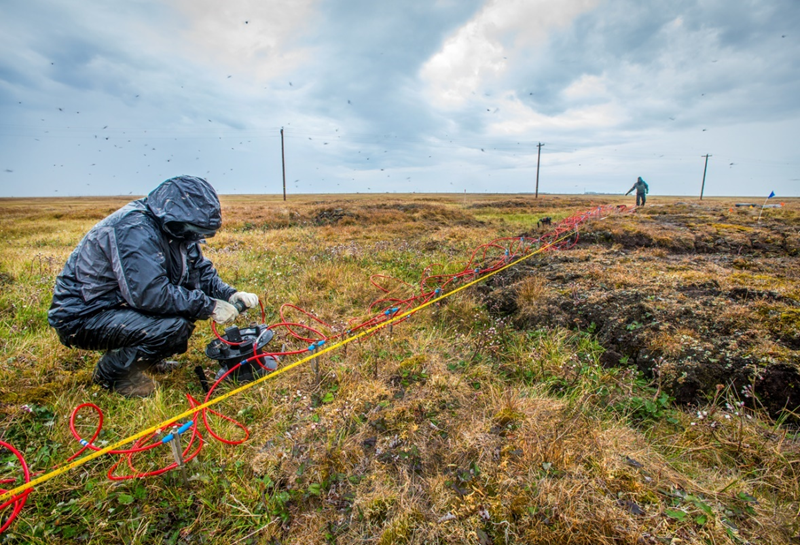Reviewed by Alex SmithJun 27 2022
Water can move through the ground more rapidly when permafrost thaws, resulting in a complicated subsurface flow system.
 Taking measurements at the Barrow Environmental Observatory, 330 miles north of the Arctic Circle for the Next-Generation Ecosystem Experiment (NGEE-Arctic). The project seeks to improve climate model predictions by studying Arctic terrestrial ecosystems. Image Credit: Roy Kaltschmidt, Lawrence Berkeley National Laboratory.
Taking measurements at the Barrow Environmental Observatory, 330 miles north of the Arctic Circle for the Next-Generation Ecosystem Experiment (NGEE-Arctic). The project seeks to improve climate model predictions by studying Arctic terrestrial ecosystems. Image Credit: Roy Kaltschmidt, Lawrence Berkeley National Laboratory.
At the Barrow Environmental Observatory in Alaska, scientists gained an understanding of this process by performing daily measurements of the electrical resistivity of the ground.
The outcomes display that vegetation and the snowpack that houses on the vegetation in winter regulate the flow of water in the ground and the temperatures of the ground. Where snow deposits, ground temperatures remain warmer, allowing water and energy from rain and snowmelt to quickly permeate the ground. Where there is little snow cover, the ground is colder, which hinders water flow.
The Impact
Stressing the link between above- and belowground properties and processes in the Arctic will help enhance scientists’ predictions of how the Arctic pertains to wider climate change.
Also, the outcomes display that Arctic systems are altering in a rapid manner, and that permafrost at the research team’s study site can vanish within the next 10 years. Variations in snowpack distribution and rainfall patterns can expedite this process.
Summary
Climate change is resulting in quick changes in Arctic ecosystems. However, researchers have not gathered sufficient information to disentangle complicated subsurface processes linked to such changes. By making use of geophysical and in situ sensing, scientists closed an observational gap linked to thermohydrological dynamics in intermittent permafrost systems.
Scientists gathered data for more than two years and were able to unravel the impacts of topography, vegetation, and snow thickness distribution on subsurface thermohydrological properties and processes.
Accumulation of large snow next to tall shrubs dissociates the ground and enables quick and downward heat flow, whereas thinner snowpack above low graminoid grasses and sedges leads to surficial freezing and prevents water from infiltrating the subsurface.
Examining brief disturbances like heavy rainfall or snowmelt, the research group discovered that lateral flow could be a forcing factor in the development of a talik, a subsurface layer in permafrost that tends to remain unfrozen all year-round. Interannual measurements denote that deep permafrost temperatures increased by around 0.2 °C for more than two years.
The outcomes of the study indicate that snow-vegetation-subsurface processes have been coupled tightly and will enhance forecasts of Arctic feedback to climate change, such as how subsurface thermohydrology impacts methane fluxes and carbon dioxide.
This study was financially supported by the Department of Energy Office of Science, Office of Biological and Environmental Research.
Journal Reference:
Sebastian, U., et al. (2022) Geophysical Monitoring Shows that Spatial Heterogeneity in Thermohydrological Dynamics Reshapes a Transitional Permafrost System. Geophysical Research Letters. doi.org/10.1029/2020gl091149.